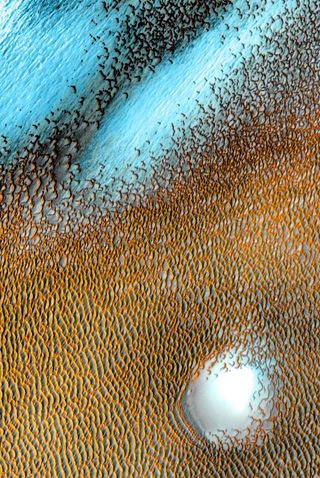Weird 'blue' dunes speckle the surface of Mars in NASA photo

What might look like a scene from a science fiction film is actually a real-life image of dunes speckling the surface of Mars.
The gorgeous photo from NASA's Odyssey orbiter released April 8 reveals the extreme and varying temperatures in a sea of dunes at Mars' northern polar cap, which are formed into long and weaving lines by winds over time. The Red Planet does not actually have blue patches; the blue regions in this false-color image represent colder areas, and warmer features are seen as a yellowish-orange color, NASA officials said.
The image depicts an area about 19 miles (30 kilometers) wide, but the total scope of dunes at Mars' northern polar cap stretches out much farther, covering an area the size of Texas.
In photos: Mars caves and lava tubes

Sand dunes can be found in various locations around the Red Planet. From the polar region depicted in this image to the floors of craters and more, Mars' dunes are fascinating features on the planet's surface. Some of the dunes on the planet have even been spotted covered in frost, which comes and goes with the seasons.
While NASA released the new image April 8, it is composed of images captured from December 2002 to November 2004 by the THEMIS (Thermal Emission Imaging System) instrument on board NASA's Mars Odyssey orbiter. The image is part of a set of photos released recently to celebrate the 20th anniversary of Odyssey, which launched on April 7, 2001 and began observing Mars in October of that year.
Odyssey is stilly studying the Red Planet; it holds the record for the longest active spacecraft continuously orbiting another planet. The craft's primary mission has been to study Mars' environment and collect data to inform and protect future Mars missions. Aside from THEMIS, the craft carries instruments called GRS (Gamma Ray Spectrometer) and MARIE ( Mars Radiation Environment Experiment).
Get the Space.com Newsletter
Breaking space news, the latest updates on rocket launches, skywatching events and more!
Email Chelsea Gohd at cgohd@space.com or follow her on Twitter @chelsea_gohd. Follow us on Twitter @Spacedotcom and on Facebook.
Join our Space Forums to keep talking space on the latest missions, night sky and more! And if you have a news tip, correction or comment, let us know at: community@space.com.

Chelsea “Foxanne” Gohd joined Space.com in 2018 and is now a Senior Writer, writing about everything from climate change to planetary science and human spaceflight in both articles and on-camera in videos. With a degree in Public Health and biological sciences, Chelsea has written and worked for institutions including the American Museum of Natural History, Scientific American, Discover Magazine Blog, Astronomy Magazine and Live Science. When not writing, editing or filming something space-y, Chelsea "Foxanne" Gohd is writing music and performing as Foxanne, even launching a song to space in 2021 with Inspiration4. You can follow her on Twitter @chelsea_gohd and @foxannemusic.
